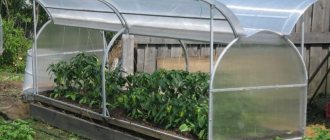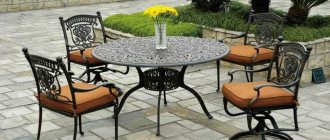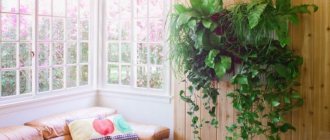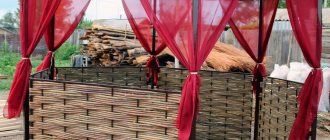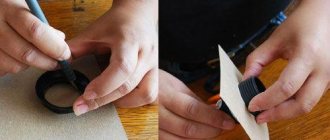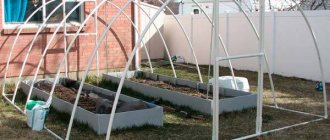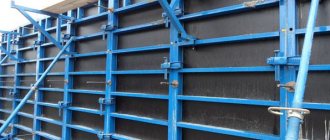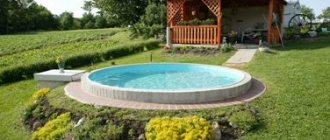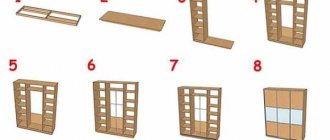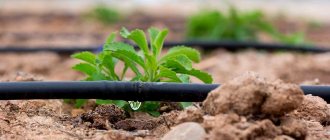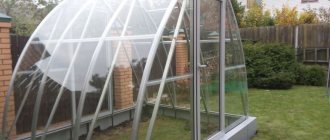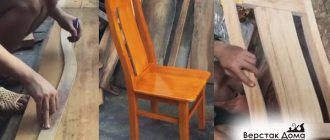Having even a small plot of land, it is difficult to do without a greenhouse. Grow seedlings, get an early harvest, protect them from possible frost, from heat, make the plants in the flowerbed bloom earlier - all this can be done with the help of this device. Moreover, making a greenhouse with your own hands is not difficult. There are very simple designs, there are more complex ones, but the manufacture of any of them does not require special education.
The frame for a greenhouse can be made of wood (boards), metal (angle, profile pipe or fittings) or PVC pipes (round or square). The greenhouse is covered with the same materials as the greenhouse : film, spunbond (also called agrofibre or non-woven covering material), polycarbonate and glass. Since the size of greenhouses is smaller (plants in greenhouses are maintained from the outside), the requirements for them are not so stringent: even strong winds are not afraid of them.
Greenhouse sizes
Since in a greenhouse the plants are served from the outside, its width is chosen so that it is comfortable for you to process plants planted closer to the middle. You determine this experimentally: sit down and try to reach some area with your hand. Measure the distance. You get the width of the greenhouse with a one-sided approach. This is if the greenhouse is located in such a way that it is impossible to get to it from the other side (near a wall, for example). If you can approach from both sides, you double this result.
It is important to be comfortable at work
The distance is different for each person: height and physical condition affect. You should not chase savings by making it wider than necessary. You will have to spend a lot of time weeding, loosening, fertilizing, and other work. A couple of hours in an uncomfortable position, and there is no strength left. Therefore, it is better to make the greenhouse a little narrower, but to make it convenient to work: while enjoying your work, you spend less effort.
And the length of the greenhouse is chosen based on the layout of the site. It's arbitrary.
Choosing the type of covering for a greenhouse
One of the common materials for covering greenhouses is reinforced film. The material is quite durable; there is no need to remove the film from the frame in winter. A greenhouse covering made of reinforced film can be used for several years.
Greenhouse covered with reinforced film
The main advantages of reinforced film for covering greenhouses:
- High mechanical strength, resistance to tearing and stretching.
- Possible operation in a wide temperature range from -40C to +70C.
- Maintainability – damaged areas of the film are easy to replace.
- It is not damaged by exposure to precipitation and can withstand the weight of snow during heavy snowfalls. Reinforced film for greenhouses for cucumbers is not damaged by hail.
- The film perfectly retains heat in the greenhouse and helps create the required microclimate for growing cucumbers; has high light conductivity.
- Reinforced film coating is very economical and, due to its low cost, is available to a wide range of consumers.
Arched greenhouse A more expensive covering for greenhouses is a new generation material - cellular polycarbonate. Polycarbonate has undeniable advantages in strength and durability compared to other materials.
Advantages of cellular polycarbonate when constructing greenhouse covers for cucumbers:
- Greenhouse covering structures made of cellular polycarbonate are characterized by low weight and high strength values.
- Polycarbonate has high light-conducting characteristics. The light entering the greenhouse is quite enough for the development of planted cucumbers.
- Resistance of the coating to weather conditions: the flexible coating made of cellular polycarbonate does not collapse during hail, snow, or heavy rain.
- High thermal insulation, the ability to reliably maintain the temperature in a greenhouse.
- The high cost of polycarbonate is compensated by the long service life of the greenhouse for cucumbers.
Glass is often used to cover greenhouses. This material is fragile; any load, even hail, can lead to damage to the coating. Typically, glass is used in constantly operating greenhouses that produce crops all year round. The large weight of glass greenhouse frames suggests their use in greenhouses with a base.
Polycarbonate greenhouse
The latest film materials: polyethylene; polyvinyl chloride (PVC); ethylene vinyl acetate film (se-vilene); spunbond; agril; lutrasil and others, made it possible to almost completely abandon the use of glass to cover greenhouses.
A simple greenhouse made of arcs under film or spunbond
This greenhouse is made of several boards, knocked down to the required dimensions, arcs of PVC pipes, which are attached to a wooden base. The tops of these arcs are connected at the top by a beam or the same pipe. If it is a timber, it needs to be well processed, rounding the edges so that the film does not tear.
A simple greenhouse made of boards and PVC arches
How to secure the arches
How to attach arcs of PVC pipes to a greenhouse frame. They are most often secured using metal perforated tape. Take a small piece of it about 5-6 centimeters, screws and a screwdriver. And they are secured on both sides. To be on the safe side, you can do it twice.
This fastening can be repeated twice
In exactly the same way, you can fasten them from the inside to hold them tighter by adding bars.
The greenhouse arcs are fixed inside the frame
Another option: drive in pieces of reinforcement near the frame, place pipes on them and only then secure them with clamps to the frame boards. This option is more reliable.
Read how to make high beds (for increased yield) here.
How to attach the film
You can attach the film to PVC pipes using double-sided tape. But only if inexpensive polyethylene film was used: it is impossible to tear it off without damaging it, and polyethylene lasts no more than a year. So for a seasonal greenhouse this is a “cheap and cheerful” option. The second method is special clips for fixing films and anything that can replace them - a piece of an old hose cut lengthwise, a clamp for pipes that are used for installing pipelines, office binders, etc.
How else can you fix the film on the meadows of a greenhouse or greenhouse?
It also makes sense to secure a block on both sides along the edges of the film. To do this, the film is cut to a length greater than necessary, a block is wrapped in the excess and the film is secured to it. Now you have a piece of film with bars attached to its short sides. Leave one on one side, throw the second on the other. Now you don’t need to press the film to the ground with stones: the block holds it well. It is also convenient to open the greenhouse for ventilation; wrap the film and place it on top.
A block wrapped around the edges of the film makes the work easier
You can use small nails to attach the film, but place washers under the caps. It is faster to work with a construction stapler with staples. To prevent the film from tearing at the attachment points, it is padded with something. You can use thick braid or just a strip of fabric, and hammer fasteners into it.
Methods of attaching the film to the bar and to the arcs
More powerful option
If there is a need to make a greenhouse with PVC arches more reliable, wooden posts are nailed to the board base in the center of the short side. A board is attached to them on the edge, in which holes are pre-drilled with a diameter larger than the outer diameter of the pipes.
This greenhouse can be used not only for growing peppers or eggplants. Having grown the side posts if necessary, you can tie up cucumbers or tomatoes
During installation, the pipe is threaded through the hole. You can fasten it on the sides as suggested above, or you can do it another way: first install pins in the bars and put the pipe on them.
How to secure a longitudinal beam in racks
The simplest greenhouse
The good thing about PVC pipes is that they are easy to bend. Also because they weigh little. An ideal option for a lightweight, portable greenhouse, especially if combined with spunbond. This material can be sewn. Take a piece with a density of 30 kg/m2 and make drawstrings in it in increments of 50-60 cm. For the drawstring, stitch across a strip of the same material about 10 cm wide (it is stitched on both sides). Insert pipes cut into the required lengths inside.
This is what you should get: a covering material with arches threaded through the drawstrings
Now all this can be installed on the bed: stick pegs in two rows on one side and the other of the bed, and place a pipe on them. You immediately get a ready-made greenhouse. And what’s more convenient: you open and close the plants simply by collecting or straightening the spunbond on the arc. This is a very convenient temporary greenhouse: as soon as it is not needed, it can be removed and folded in a couple of minutes.
Greenhouse - it couldn't be simpler
Read about drip irrigation systems for gardens, greenhouses and hotbeds here.
How to make a simple greenhouse for cucumbers with your own hands
As already mentioned, there are many options for arranging greenhouses, each of which takes into account the specifics of a particular crop, the cultivation of which is planned in this case.
Let's look at one example of the simplest design - a do-it-yourself film greenhouse designed for cucumbers. When building a greenhouse for cucumbers, it is important to calculate in advance how much space is needed for adult plants
The first stage is preparing the site for installation and arranging a drainage layer. In this case, you will need to remove the top layer of soil (about 50 cm) and fill the bottom of the hole with crushed stone or gravel. Then a layer of organic waste is placed in the hole and covered with earth. In this case, the top layer of soil should be at least 30 cm.
Then you need to make a fence around the perimeter of the prepared site. Using steel wire, stiffening ribs are made, from which the frame for the covering material will later be made. In the process of work, you can also use soft wire, using it to connect more rigid elements. This will give the entire structure greater strength.
A film is used as a covering material, which is stretched over the ribs and fixed. In hot weather, the film can be lifted so that the plants are additionally ventilated, and when it gets cooler, you can additionally throw a thick fabric or blanket over the greenhouse, which will provide warmth to the cucumbers.
The covering material can not be attached to the arches, but heavy stones or bricks can be used to fix it at the base of the greenhouse
Helpful advice! After the cucumbers grow and no longer need protection, it is not necessary to completely dismantle the greenhouse. It is very convenient to simply remove the film and leave the frame as a support for weaving plants.
Triangular greenhouse made of boards
This greenhouse is good for seedlings, but you can make it for peppers and eggplants. A stand is nailed in the middle of the base. There are two inclined boards attached to it. The cross section results in a triangle. If you need a long greenhouse, the same structure is installed approximately every meter. All tops are connected with a long bar or pipe. This greenhouse has a simple and convenient design.
Cucumbers are grown with it only until they begin to curl. Under the cucumbers, the covering material is removed, posts are nailed (screwed) to the sides, and twine is pulled between them.
Triangular greenhouse made of boards
Here's how to remake such a greenhouse for cucumbers
How do borage differ from greenhouses for other plants?
Tall greenhouse for cucumbers Almost every summer resident is familiar with the construction of simple greenhouses and film shelters. But different crops require certain conditions, so greenhouses for cucumbers must be built taking into account all the features of agricultural technology:
- plants are afraid of sudden changes in temperature, so it is necessary to consider a method of ventilation and shelter from the scorching rays of the sun;
- the cucumber vines need to be tied up, respectively, the height of the greenhouse must be at least 1.5 m and devices for attaching the twine are required;
- one bush requires a certain amount of nutrients to form a harvest, so the greenhouse must be spacious;
- if non-self-pollinating varieties are used, it is necessary to ensure free access of insects to the flowers.
Cucumbers in a greenhouse must be provided with all conditions for normal growing season
Greenhouse “Breadbox” and “Butterfly” - photo
This design is called a “bread box” because it looks exactly like a plastic bread container. Its lid also rises upward, hiding behind the second half. If you look at the photo, you will understand everything.
You can weld such a greenhouse-breadbox with your own hands from a profile pipe
There are two types of such products: opening on one or both sides. If it is shallow, you can work with a lid that opens on one side. If the width is more than a meter, it will be easier to work if there is access from both sides. This design with two opening sides has its own name: “Snail”.
A film or spunbond is stretched over the manufactured frame, but polycarbonate is more popular for this design.
The second design differs in the type of door opening. Its vault is also made on arches, but opens on hinges upward (see picture).
Butterfly greenhouse: when open, the lids resemble wings
They can be installed directly on the ground or on a prepared foundation made of bricks or timber. In some cases, the lids do not open immediately from the ground, but there is a small side of 15-20 cm.
Read how to make a beautiful vegetable garden (decorative and functional) here.
From scrap materials
Turning unnecessary things into useful products - our people have no equal in this. They make greenhouses from things you would never even think of.
For example, you can easily make a greenhouse with your own hands from old window frames. When replacing windows, do not rush to throw them away. They can be used to make an excellent greenhouse. Moreover, the designs may be different. The simplest is a body made of boards, to which a window frame (with glass, of course) is attached on top as a lid.
A simple frame greenhouse: a wooden frame to which an old window frame is hinged
To ensure that the plants receive maximum light, one side of the frame is made higher (which faces south or east). There are different frames, any of them can be used for these purposes. As proof, here is a photo gallery of greenhouses made from frames that were made with their own hands by zealous owners.
Two frames made up of a house: the plants are covered from drafts, and the sides can be covered with film
Is the frame assembled? Why take it apart? Just make a body to fit its dimensions
You can also install two side by side. Get a long bed
You can also make an accordion so that the frames don’t stick out too much
They make greenhouses out of barrels. Cover with an old umbrella made of transparent film or cut-off plastic water cans.
Greenhouse from an old barrel
Way to grow cucumbers
A homemade greenhouse can be made from a plastic or foam box. Although “do” is a strong word. All you need to do is stretch the film.
Everything ingenious is simple
Do you have a plastic box? Can be adapted for seedlings
Preparing for construction - sizing and drawing
The size of the greenhouse directly depends on the amount of material from which the structure will be built. For example, it is better not to use materials such as mesh or wicker to build high arched greenhouses. The optimal dimensions for these greenhouses are length 3–5 m, width 2.5–3 m, height 1.8–2 m. If the greenhouse is higher, the structure will be very unstable. If the width is larger, it may be necessary to build additional supports inside the greenhouse. Window frames or plastic pipes are suitable for building any greenhouses.
Drawing of a long greenhouse with a gable roof
In our case, we will build a greenhouse from plastic containers and edged bars. It will be a reliable and durable structure with high light transmittance. Before carrying out construction work, a drawing of the future structure should be drawn up. To do this, you can use plain paper and a pencil. If possible, you can use computer programs for modeling.
The drawing must schematically depict the structure of the greenhouse, including the load-bearing base, end and side walls, roof and doors. The size is indicated next to each element. And you should also list the material that will be used in the work.
Drawing of a frame gable greenhouse 6 m long
Above is a diagram for a gable greenhouse 6x3.5x1.6 m. The height is measured along the side wall without taking into account the roof. The step between the vertical guides of the frame is 1 m. If necessary, the size of the greenhouse can be reduced - this will reduce the volume of required material.
In the step-by-step technology that will be described below, we will build a greenhouse from bottles 4 m long, 2.5 m wide, 2 m high. Taking these dimensions into account, the material will be calculated.
After drawing up the drawing, you can proceed to choosing a location for construction. It is optimal if it is a well-lit piece of land on the south or south-east side. The soil for the greenhouse must be dry and clean. If desired, part of the soil can be removed (30–40 cm) and replaced with new soil brought from places with more fertile soil.
Mini-greenhouses for seedlings
For those who grow seedlings for their own vegetable garden or flower garden, large volumes are useless. We need small greenhouses. Moreover, many grow seedlings on balconies. All of the above designs can be used for a balcony in reduced sizes. For very small plantings, you can even take plastic egg trays. On one side there will be a container for soil and a lid instead of a shelter. Look at the photos for other ideas.
Make a greenhouse cabinet from wooden planks and cover it with polycarbonate
A plastic egg tray can also be used as a mini-greenhouse for seedlings
A box is assembled from planks, glass is inserted, film or spunbond is stretched, and polycarbonate is attached. Mini greenhouse for seedlings is ready
Thick wire arcs attached to the box, film on top. The greenhouse for the balcony is ready
The use of plastic bottles is already common, only the shape is non-standard. The bottle is only cut and a glass with seedlings is inserted inside, or you can plant it directly in the lower part...
Another way to make a small greenhouse
Their plastic tray can be an individual greenhouse for seedlings planted in the ground
Another design of a small greenhouse for a balcony made of arcs
And this is a portable mini-greenhouse for plants
You can assemble a greenhouse with your own hands in a few hours. There is no need to build any complex structures. Everything is very simple, economical and practical.
How to choose the appropriate material for the frame and lining of a greenhouse for cucumbers?
After assessing the area of the site and choosing the shape of the greenhouse, you need to decide on the materials. The size of the structure and the possibility of being moved to another location should be taken into account. To build a stationary greenhouse, it is better to give preference to wood, metal, polycarbonate and glass. Seasonal options can be made from plastic and film.
When choosing a building material, you need to focus on climatic conditions, how sharp the changes in night temperatures are, and whether the humidity is high. The choice of material with the required level of thermal conductivity and corrosion resistance depends on this.
Greenhouses with different skins have different access to watering plants; you need to choose the most convenient option, taking into account the size of the beds.
